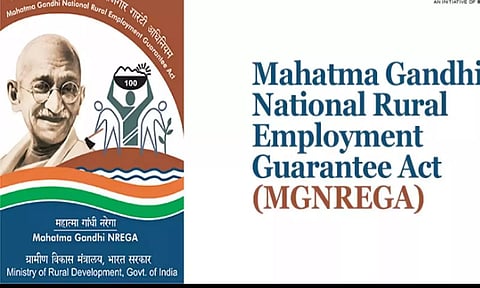
- Home
- Live Blog
- Breaking News
- Top Headlines
- Cities
- NE News
- Sentinel Media
- Sports
- Education
- Jobs

Agrarian crises triggered by crop failures due to natural disasters reduce a large section of farmers in India into daily wage earners. They migrate to cities and urban areas for livelihood but face uncertainty in the job market as they are considered unskilled outside farm activities. The Mahatma Gandhi National Rural Employment Guarantee Scheme is a demand-driven scheme on which these farmers turned unskilled workers can fall back when they have no other livelihood opportunities. A nearly 40% increase in Revised Estimates of budgetary allocations in 2024-25 from the Budget Estimates in the Union Budget for 2024-25 is reflective of growing demand for jobs under the flagship scheme of employment guarantee. Plugging the gaps in its implementation, such as wage calculation, delay in wage payment, and social audit, is crucial to achieving the core objective of ensuring the livelihood security of the rural poor. The scheme is much more productive compared to various cash payout schemes, as it leads to asset creation, while the latter is mostly spent on household consumption with no asset creation. The Mahatma Gandhi National Rural Employment Guarantee Act, 2005, mandates providing at least 100 days of unskilled manual work as guaranteed employment in a financial year to an adult member of a rural household on demand. The Act provides for an additional 50 days of unskilled wage employment in a financial year in drought/natural calamity-notified rural areas. This provision has great significance for flood-ravaged Assam, as it can ensure at least 150 days of employment for thousands of flood-affected families and build their resilience against the annual disaster. Timely and adequate payment of wages against work done under the scheme can provide financial relief to poor farm households in distress and help them cope with the financial woes in the short term. The Ministry of Rural Development notifies the Mahatma Gandhi NREGA wage rate every year for different states and Union Territories. The Ministry revises the wages every year, and to compensate the MNREGA workers against inflation, the wage rate is changed based on the change in the Consumer Price Index for Agricultural Labour (CPI-AL). Each state can provide wages over and above the rate notified by the central government. The Parliamentary Standing on Rural Development and Panchayati Raj, however, finds the calculation of wage rate with base year of 2009-2010 “obsolete and saturated.” The Committee, in one of its latest reports, reiterates its recommendation to the Ministry to explore the feasibility of revising the base year and base rate to bring relief to the poor rural masses of the country who rely upon MGNREGA for their livelihoods. The delay in payment of wages is another gap that needs to be addressed on an urgent priority so that the objective of the Act to provide livelihood protection is ensured in the true sense of the term. The Aadhaar-based payment system linking the wage seeker’s bank account with the Aadhaar number is an innovative approach to address the issue of timely payment, bringing more transparency and weeding out fake job cards. The parliamentary panel, however, expressed its reservation on making Aadhaar-based payment mandatory and recommended that an alternative mechanism should always operate side by side to ensure that the primary goal of MNREGA to provide wages does not get defeated due to a lack of proper implementation of technology. The rationale of the committee to raise objection to making the Aadhaar-based payment system mandatory is that the targeted community under MNREGA is “mainly less educated, technologically challenged, and having less fiscal management know-how.” Nevertheless, completion of Aadhaar seeding of more than 98% of the total 13 crore active MNREGA workers also speaks volumes about the acceptance of the technology-enabled payment system. Official data shows that in April, more than 96% of beneficiaries received their wages through this system, which makes it a viable solution to address the issue of delay in wage payment. The conduct of a regular social audit of all MNREGA projects by the Gram Sabha is a key provision of the Act to ensure real-time monitoring of the projects and judicious utilisation of funds allocated and released. The committee found that only 32% of Gram Panchayats carried out an audit once a year in 2023, which reveals a wide gap in the monitoring mechanism and violation of the Act provision. The Committee is of the view that the conducting of timely social audits not only ensures the transparency in the expenditure of funds at the Gram Panchayat level but is also a tool to recover the misappropriated funds reported after the audit. The formation of a Joint Task Force on Streamlining Social Audit under the chairpersonship of the Additional Deputy Controller and Auditor General is a laudable initiative. The Terms of Reference of the Task Force include developing norms for ensuring the financial, administrative, and functional independence and autonomy of the social audit units across. Strengthening the checks and balances is critical to improving MNREGA implementation across India.